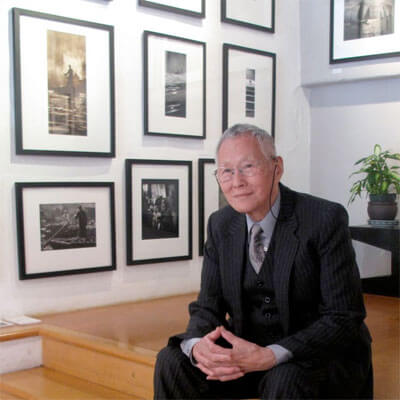Fan Ho’s (born in Shanghai in 1931) photographic career started at the early age of 14 when given his first Kodak Brownie from his father. Within the first year he won his first award in 1949 in Shanghai. At the age of 18, he acquired his twin lens Rolleiflex with which he captured all his famous work after he moved to Hong Kong with his parents and continued to purse his love for photography.
Dubbed the “Cartier-Bresson of the East”, Fan Ho patiently waited for ‘the decisive moment’; very often a collision of the unexpected, framed against a very clever composed background of geometrical construction, patterns and texture. He often created drama and atmosphere with backlit effects or through the combination of smoke and light. His favorite locations were the streets, alleys and markets around dusk or life on the sea.
What made his work so intensely human is his love for the common Hong Kong people: Coolies, vendors, hawkers selling fruits and vegetables, kids playing in the street or doing their homework, people crossing the street… He never intended to create a historic record of the city’s buildings and monuments; rather he aimed to capture the soul of Hong Kong, the hardship and resilience of its citizens.
Fan Ho was most prolific in his teens and 20s and created his biggest body of work before he reached the tender age of 28. His work did not go by unnoticed at his time. He won close to 300 local and international awards and titles in his day through competing in the salons. His talent was also spotted by the film industry where he started out as an actor before moving to film directing until retiring at 65.
Fan Ho is a Fellow of the Photographic Society and the Royal Society of Arts in England, and an Honorary Member of the Photographic societies of Singapore, Argentina, Brazil, Germany, France, Italy and Belgium. He most recently won a "Life-time Achievement Award, the 2nd Global Chinese International Photography Award, China, 2015" by the Chinese Photographic Society (Guangzhou).
During his long career he has taught photography and film making at a dozen universities worldwide. His work is in many private and public collection of which most notable are: M+ Museum, Hong Kong, Heritage Museum, Hong Kong, Bibliothèque National de France, Paris, France, San Francisco Museum of Modern Art, USA, Santa Barbara Museum of Art, USA and many more.
Source: fanho-forgetmenot.com
